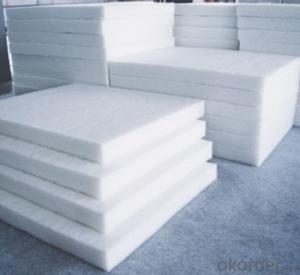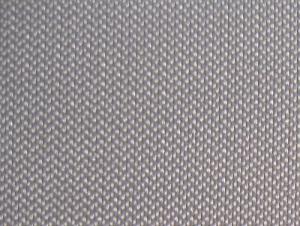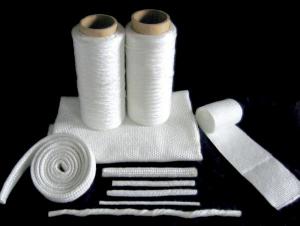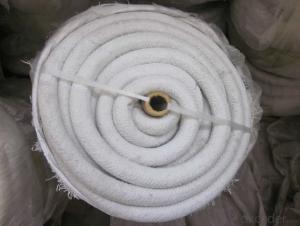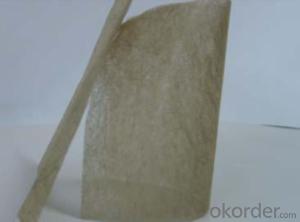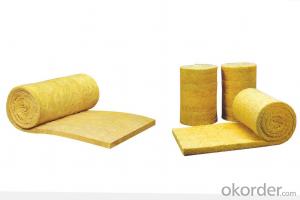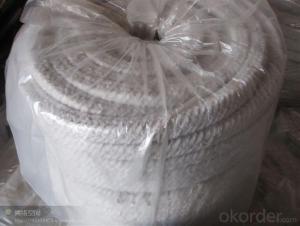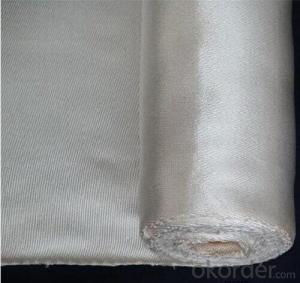High temperature ceramic fiber refractory fabric for heat insulation
- Loading Port:
- Shanghai
- Payment Terms:
- TT OR LC
- Min Order Qty:
- 1 m.t.
- Supply Capability:
- 111 m.t./month
OKorder Service Pledge
OKorder Financial Service
You Might Also Like
Specifications
1.Ceramic fiber cloth
2.1260C
3.thickness:1-5mm
4.reasonable price
High temperature ceramic fiber refractory fabric for heat insulation
Specifications:
Temperature:450C-1260C
Thickness:1.5mm-6.0mm
Width:500mm-1200mm
Density:500kg+/-30kg/m
Reinforcing materials: glass fiber wire, stainless steel wire
1. Products Details:
Hitex Ceramic Fiber Cloth is a woven fabric made from our high quality ceramic fiber woven yarn. The cloth is reinforced with fiberglass filament, or optional Inconel/alloy steel wire reinforcement. It is featured with heat insulation and high temperature protective materials in all kind of thermal installations and heat-conducting systems, widely used in welding, foundry works, aluminum and steel mills, boiler insulation and seal, shipyards, refineries, power plants and chemical plants.
2. Product Advantages:
1.Resistance to high temperature and chemical erosion
2.High mechanical strength
3.Low thermal conductivity
4.Low thermal storage
5.Resistance to heat shock
6.Easy installation
3. Technical Data:
Item | Ceramic Fiber Cloth | |
Classification Temperature | 1260C | 1260C |
Work Temperature | 450C | 1000C |
Basic Material | Fiberglass Reinforced | Stainless Steel Reinforced |
Theoretical Density ( kg/ m3) | 500±15 | |
Moisture Content (%) | ≤2 | |
Warp Density | 48~60 Piece/10cm | |
Weft Density | 21~30 Piece/10cm | |
Organic Content (%) | ≤15 | |
Specification (mm) | L:30,000mm / W:1,000mm / T:2~3mm | |
Packing | Plastic bag inside, woven bag outside | |
- Q:What are the different weight options for glass fiber textiles?
- Glass fiber textiles come in a variety of weight options to cater to different applications and requirements. The weight of glass fiber textiles is typically measured in grams per square meter (gsm) or ounces per square yard (oz/yd²). The weight options for glass fiber textiles can range from very light to heavy, depending on the intended use. Lighter weight options, such as those around 100-200 gsm (3-6 oz/yd²), are often used in applications where flexibility and drapeability are important, such as in clothing, curtains, and lightweight reinforcements. Medium weight options, typically ranging from 200-400 gsm (6-12 oz/yd²), are commonly used in a wide range of applications, including automotive parts, boat hulls, and composite reinforcements. These textiles offer a good balance between strength and flexibility, making them suitable for various structural and reinforcement purposes. For more demanding applications that require higher strength and rigidity, heavier weight options are available. These can range from 400-1000 gsm (12-30 oz/yd²) or even higher. These textiles are commonly used in industries such as aerospace, construction, and infrastructure, where the materials need to withstand significant loads and provide enhanced structural integrity. Ultimately, the choice of weight option for glass fiber textiles depends on the specific requirements of the application, including the desired level of strength, flexibility, and rigidity. Manufacturers and suppliers of glass fiber textiles offer a wide range of weight options to cater to the diverse needs of different industries and applications.
- Q:What's the custom code for fiberglass screen? Anybody know, it's urgent!
- If you are not familiar with the classification of customs codes, please use the customs code keyword to refer to 7019
- Q:Are glass fiber textiles resistant to oil or grease?
- Yes, glass fiber textiles are resistant to oil and grease. Glass fibers have a non-reactive nature, which makes them highly resistant to most chemicals, including oil and grease. This resistance is due to the fact that glass fibers are made from inorganic materials and do not contain any organic compounds that can be easily degraded by oil or grease. Therefore, glass fiber textiles are commonly used in applications where resistance to oil and grease is required, such as in the automotive industry, industrial equipment, and oil and gas pipelines.
- Q:Can glass fiber textiles be used for medical applications?
- Glass fiber textiles have the ability to be utilized in medical applications. These textiles are created by weaving together fine strands of glass fibers to produce a fabric. There are several qualities of these textiles that make them appropriate for medical use. Firstly, glass fiber textiles are biocompatible, which means they are unlikely to cause any negative reactions when they come into contact with the human body. This characteristic is crucial for medical applications as it guarantees that the textile will not cause any harm or discomfort to the patient. Secondly, glass fiber textiles possess resistance to chemicals and can endure processes of sterilization, such as autoclaving. This makes them ideal for use in medical environments where maintaining sterility is of utmost importance, such as surgical gowns, drapes, or wound dressings. Moreover, glass fiber textiles exhibit exceptional strength and durability, making them appropriate for use in medical devices and implants. For instance, they can be utilized to reinforce prosthetic limbs, create orthopedic braces, or serve as a component in surgical sutures. Additionally, glass fiber textiles possess thermal insulation properties, which can be advantageous in medical applications. They can be employed as insulation in medical devices that are sensitive to temperature or in the construction of incubators and thermal blankets for premature infants. In conclusion, glass fiber textiles can be employed in various medical applications due to their biocompatibility, resistance to chemicals, strength, durability, and thermal insulation properties. Their adaptability and suitability for medical use make them a viable choice for enhancing healthcare and improving patient outcomes.
- Q:What are the different applications of glass fiber textile?
- Glass fiber textile has a wide range of applications due to its unique properties and versatility. Some of the different applications of glass fiber textile include: 1. Reinforcement in composite materials: Glass fiber textile is commonly used as reinforcement in composite materials such as fiberglass, where it provides strength and stiffness. It is widely used in industries like automotive, aerospace, and construction for manufacturing parts and structures that require high strength-to-weight ratios. 2. Insulation: Glass fiber textile is an excellent thermal insulator, which makes it ideal for applications where heat insulation is required. It is commonly used in the construction industry for insulating walls, roofs, and pipes, as well as in appliances and equipment that generate heat, such as ovens and furnaces. 3. Filtration: Glass fiber textile is often used in filtration systems due to its high porosity and ability to capture fine particles. It is commonly used in air filters, water filters, and oil filters to remove impurities and ensure clean and pure fluids or air. 4. Electrical insulation: Glass fiber textile is an excellent electrical insulator, making it suitable for applications where electrical insulation is required. It is used in electrical cables, wires, and circuit boards to prevent electrical leakage and ensure safety. 5. Textile industry: Glass fiber textile is also used in the textile industry for manufacturing fabrics and textiles that are durable, lightweight, and resistant to heat and chemicals. It is commonly used in applications such as protective clothing, upholstery, and curtains. 6. Reinforcement in concrete: Glass fiber textile is often used as a reinforcement material in concrete structures to improve their mechanical properties. It helps to control cracking and increase the durability and strength of concrete, making it suitable for applications like bridges, tunnels, and buildings. 7. Composite pipes and tanks: Glass fiber textile is widely used in the manufacturing of pipes and tanks due to its corrosion resistance and high strength. It is commonly used in industries like chemical processing, oil and gas, and water treatment for transporting and storing corrosive fluids. 8. Sports equipment: Glass fiber textile is used in the production of sports equipment such as tennis rackets, hockey sticks, and fishing rods. It provides strength and flexibility to these equipment, making them more durable and efficient. Overall, glass fiber textile finds applications in various industries due to its unique properties, including strength, durability, thermal and electrical insulation, and corrosion resistance. Its versatility and wide range of applications make it an essential material in modern manufacturing processes.
- Q:Can glass fiber textiles be used in tents or camping equipment?
- Yes, glass fiber textiles can be used in tents or camping equipment. Glass fiber textiles are lightweight, durable, and have excellent insulation properties, making them suitable for use in tents and camping equipment to provide insulation, strength, and protection from external elements.
- Q:Is glass fiber textile resistant to chemicals?
- Yes, glass fiber textile is generally resistant to chemicals. Glass fiber is known for its excellent chemical resistance, making it suitable for various applications where exposure to chemicals is common. It is highly resistant to acids, alkalis, solvents, and other corrosive substances. This resistance is due to the inherent properties of glass, such as its inertness and non-reactivity. Additionally, glass fiber textile materials can be further enhanced with specialized coatings or treatments to provide even greater chemical resistance. However, it is important to note that the specific level of chemical resistance may vary depending on the type and composition of the glass fiber textile, as well as the specific chemicals involved. Therefore, it is always recommended to consult the manufacturer's specifications or conduct appropriate testing to ensure suitability for a particular chemical environment.
- Q:Can glass fiber textile be used in sporting equipment?
- Yes, glass fiber textile can be used in sporting equipment. It is commonly used in the construction of items such as tennis rackets, hockey sticks, and bicycle frames due to its high strength, durability, and lightweight properties. Glass fiber textile provides excellent stiffness and flexibility, making it suitable for enhancing performance and improving player control in various sports.
- Q:What are the different thickness options for glass fiber textile?
- Glass fiber textile comes in a variety of thickness options to accommodate different applications and requirements. Typically, the thickness of glass fiber textile is measured in grams per square meter (gsm) or ounces per square yard (oz/yd²). The range of thickness options for glass fiber textile is commonly from 100 gsm to 600 gsm (3 oz/yd² to 18 oz/yd²). These thicknesses are suitable for a wide range of applications, including composites reinforcement, insulation, and filtration. For lightweight applications that require minimal reinforcement, lower thicknesses of glass fiber textile, such as 100 gsm to 200 gsm (3 oz/yd² to 6 oz/yd²), are commonly used. Industries like automotive, aerospace, and marine often utilize these thinner textiles where weight reduction is crucial. Medium thickness options for glass fiber textiles, ranging from 200 gsm to 400 gsm (6 oz/yd² to 12 oz/yd²), are ideal for general reinforcement purposes. These textiles offer a balance between strength and weight, making them versatile for applications like boat building, wind turbine blades, and sporting goods. Thicker glass fiber textiles are employed for heavy-duty applications that require maximum strength and durability. These textiles typically range from 400 gsm to 600 gsm (12 oz/yd² to 18 oz/yd²) and are commonly used in industries such as construction, oil and gas, and infrastructure. They are utilized for applications like concrete reinforcement, pipe wrapping, and geotextiles. It is important to note that manufacturers may offer additional thickness options beyond the mentioned range, depending on specific customer needs. In some cases, custom thicknesses can also be ordered. Ultimately, the choice of glass fiber textile thickness depends on the intended application, required strength, and weight considerations. Seeking guidance from a supplier or field expert can help determine the most suitable thickness option for a particular project.
- Q:Can glass fiber textiles be used in aerospace applications?
- Yes, glass fiber textiles can be used in aerospace applications. Glass fiber textiles have many desirable properties that make them suitable for use in aerospace. Firstly, glass fiber textiles have a high strength-to-weight ratio, which is crucial in aerospace applications where weight reduction is a priority. This allows for lighter and more fuel-efficient aircraft, which is highly beneficial in terms of performance and cost savings. Secondly, glass fiber textiles have excellent thermal properties. They can withstand high temperatures without losing their structural integrity, making them suitable for use in aerospace components that are exposed to extreme heat, such as engine parts and exhaust systems. Additionally, glass fiber textiles have good resistance to corrosion and chemicals, which is important in aerospace applications where the materials are subjected to harsh environments, such as high altitude and exposure to various fluids and fuels. Furthermore, glass fiber textiles have good electrical insulation properties, which is crucial in aerospace applications where electrical conductivity can interfere with the performance of electronic systems. Moreover, glass fiber textiles are highly versatile and can be woven into different forms, such as fabrics, mats, and tapes, making them suitable for a wide range of aerospace applications, including structural components, insulation, and composite materials. Overall, glass fiber textiles are a viable option for aerospace applications due to their high strength-to-weight ratio, excellent thermal properties, resistance to corrosion and chemicals, electrical insulation properties, and versatility in form.
1. Manufacturer Overview |
|
|---|---|
| Location | |
| Year Established | |
| Annual Output Value | |
| Main Markets | |
| Company Certifications | |
2. Manufacturer Certificates |
|
|---|---|
| a) Certification Name | |
| Range | |
| Reference | |
| Validity Period | |
3. Manufacturer Capability |
|
|---|---|
| a)Trade Capacity | |
| Nearest Port | |
| Export Percentage | |
| No.of Employees in Trade Department | |
| Language Spoken: | |
| b)Factory Information | |
| Factory Size: | |
| No. of Production Lines | |
| Contract Manufacturing | |
| Product Price Range | |
Send your message to us
High temperature ceramic fiber refractory fabric for heat insulation
- Loading Port:
- Shanghai
- Payment Terms:
- TT OR LC
- Min Order Qty:
- 1 m.t.
- Supply Capability:
- 111 m.t./month
OKorder Service Pledge
OKorder Financial Service
Similar products
New products
Hot products
Related keywords
